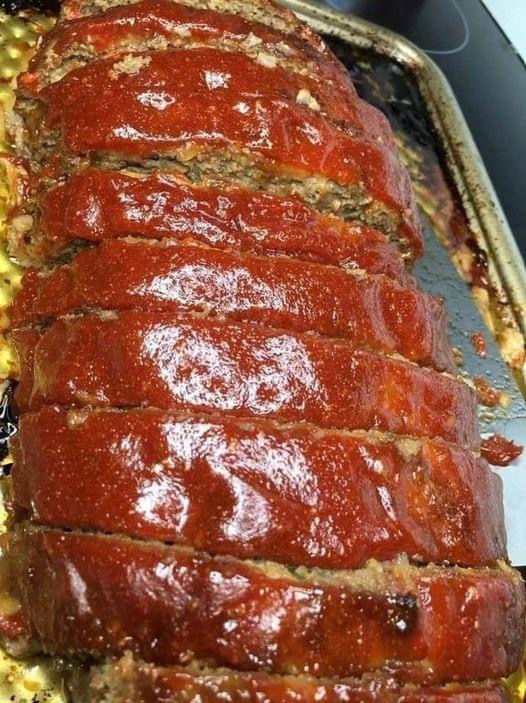Fantastic Homemade Meatloaf

Ingredients:
- Meatloaf:
- 1 1/2 pounds ground beef
- 1/2 pound ground pork
- 1 cup breadcrumbs
- 1/2 cup milk
- 1/2 cup finely chopped onion
- 1/4 cup finely chopped green bell pepper
- 2 cloves garlic, minced
- 2 large eggs
- 1/4 cup ketchup
- 2 tablespoons Worcestershire sauce
- 1 teaspoon salt
- 1/2 teaspoon black pepper
- 1/2 teaspoon dried thyme
- 1/2 teaspoon dried basil
- Glaze:
- 1/4 cup ketchup
- 2 tablespoons brown sugar
- 1 tablespoon Dijon mustard
- 1 tablespoon apple cider vinegar
Instructions:
- Preheat Oven: Preheat your oven to 350°F (175°C). Line a baking sheet with parchment paper or lightly grease a loaf pan.
- Prepare the Meatloaf Mixture:
- In a large bowl, combine the ground beef, ground pork, breadcrumbs, milk, chopped onion, chopped bell pepper, minced garlic, and eggs.
- Add the ketchup, Worcestershire sauce, salt, black pepper, thyme, and basil to the mixture.
- Mix everything together until well combined. It’s best to use your hands to mix to ensure even distribution of ingredients.
- Shape the Meatloaf:
- Transfer the meat mixture to the prepared baking sheet or loaf pan.
- Shape it into a loaf, ensuring it’s compact and even in thickness.
- Prepare the Glaze:
- In a small bowl, combine the ketchup, brown sugar, Dijon mustard, and apple cider vinegar.
- Stir until the sugar is dissolved and the glaze is smooth.
- Glaze the Meatloaf:
- Spread about half of the glaze over the top of the meatloaf, reserving the rest for later.
- Bake the Meatloaf:
- Place the meatloaf in the preheated oven.
- Bake for 45 minutes, then remove from the oven and spread the remaining glaze over the top.
- Return to the oven and bake for an additional 15-20 minutes, or until the internal temperature reaches 160°F (71°C).
- Rest and Serve:
- Allow the meatloaf to rest for about 10 minutes before slicing.
- Serve with your favorite sides, such as mashed potatoes, steamed vegetables, or a fresh salad.
History of Meatloaf
Ancient Beginnings:
The concept of combining ground meat with other ingredients to extend its volume and enhance its flavor can be traced back to ancient times. In fact, the earliest known meatloaf recipe dates back to the Roman Empire. Known as “Isicia Omentata,” this dish was made with minced meat, bread soaked in wine, and spices, then shaped into patties and cooked. This ancient version of meatloaf demonstrates the long-standing human tradition of creating economical, flavorful meals from available ingredients.
Medieval Influence:
During the medieval period, the practice of combining ground meat with other ingredients continued. Meatloaf-like dishes were prepared in Europe, often incorporating dried fruits, nuts, and various seasonings to improve taste and texture. These dishes were typically served as part of feasts and banquets, reflecting the culinary creativity and resourcefulness of the time.
American Adaptation:
Meatloaf as we know it today became popular in the United States during the late 19th and early 20th centuries. This period saw a rise in industrial meat production, which made ground meat more accessible and affordable for the average household. Additionally, the Great Depression of the 1930s further solidified meatloaf’s place in American cuisine. Families needed to stretch their food budgets, and meatloaf provided an economical way to make a small amount of meat go further by mixing it with breadcrumbs, grains, and vegetables.
World War II Era:
During World War II, meatloaf remained a staple in American kitchens due to its versatility and cost-effectiveness. Rationing of meat and other ingredients led to creative adaptations, with cooks using whatever they had on hand to make their meatloaf. This era also saw the introduction of convenience products like canned soups and packaged mixes, which made preparing meatloaf even easier.
Post-War Popularity:
In the post-war years, meatloaf continued to be a beloved dish in American households. The 1950s and 1960s saw a surge in home-cooking and family-oriented meals, with meatloaf often taking center stage at the dinner table. Cookbooks and homemaking magazines of the time featured numerous variations, from classic recipes to more adventurous takes incorporating international flavors.
Modern Variations:
Today, meatloaf remains a versatile and cherished dish in many cultures. It has evolved to include a wide range of ingredients and flavors, reflecting diverse culinary traditions. From turkey and vegetarian versions to gourmet interpretations with exotic spices and fillings, meatloaf continues to be a comfort food favorite, appreciated for its hearty, satisfying nature and endless adaptability.
Conclusion:
Meatloaf’s rich history showcases its enduring appeal as a versatile, economical, and delicious dish. From ancient Roman patties to modern-day gourmet creations, meatloaf has stood the test of time, evolving with changing tastes and ingredients while remaining a beloved staple in kitchens around the world.
Enjoy!
This homemade meatloaf is sure to become a family favorite, just like it did for Ashley’s husband. The combination of beef and pork ensures a juicy and flavorful loaf, while the sweet and tangy glaze adds the perfect finishing touch. Enjoy every bite!